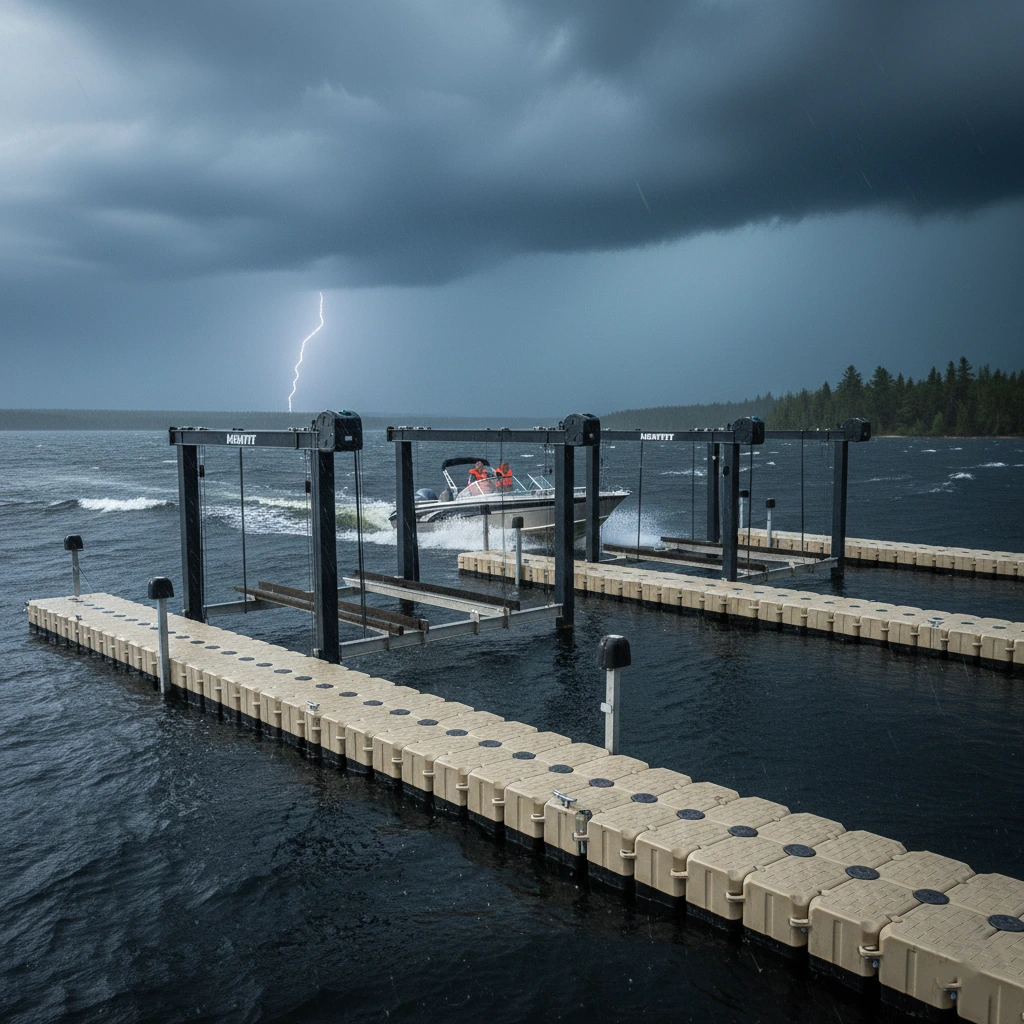Sudden Storm Alert: What Should a Boat Operator Do When Weather Changes?
For boaters enjoying the stunning waters of Alberta, sudden and dramatic weather shifts are a familiar challenge. A sunny, calm morning can quickly give way to strong winds, high waves, or a sudden downpour. Knowing what should a boat operator do when weather changes is not just good practice—it’s the single most important factor in ensuring the safety of your passengers and your vessel.
At DockStop, your premier source for docks, boatlifts, and marinas, we believe preparation is the key to safe boating. Here is your essential checklist for handling unexpected severe weather on the water.
The Immediate Response: Prioritize Safety & Control
When you first notice the signs of an approaching storm—dark clouds gathering, a sudden drop in temperature, or an increase in wind speed—immediate action is required.
1. Secure Your Passengers and Gear
- PFDs ON: The very first step is to instruct everyone on board to immediately put on a Coast Guard-approved Personal Flotation Device (PFD) or life jacket and ensure it is secured properly. This is non-negotiable.
- Keep Low and Centered: Have passengers move to the lowest point of the boat, near the centerline. This lowers the vessel’s center of gravity, significantly increasing stability. Instruct them to hold onto secure handholds.
- Stow Loose Gear: Quickly secure or stow away any loose items like fishing rods, coolers, or cushions. In rough seas, these items can become dangerous projectiles or get washed overboard.
DockStop can also help you customize your setup with other Outdoor Products and accessories designed for all-weather boating and shoreline protection.

2. Establish Control and Visibility 🚦
- Reduce Speed: Slow down immediately, but maintain enough power to maintain headway and steer effectively. Trying to outrun a storm is often counterproductive and unsafe.
- Turn on Lights: Turn on your navigation and running lights. Severe weather often brings poor visibility (rain, fog, or dark clouds), and these lights are crucial for other boaters to see you.
- Secure the Boat: Close and secure all hatches, windows, and ports to prevent swamping.
- Monitor Bilges: Ensure your bilge pump is working and keep the bilges free of water. A boat heavily laden with water is extremely unstable.
Navigating Rough Water: Steering and Seeking Shelter
Once the immediate safety measures are complete, focus on safely navigating through the rough conditions.
3. Steer Smartly into Waves
- Use an Angle: Do not take large waves straight on (head-to-beam), which can cause rolling, or from directly behind (following seas), which can cause swamping. Instead, head into the waves at a slight angle (around 45 degrees). This allows the bow to ride up and over the wave crests, providing a smoother and safer passage.
- Maintain Headway: Keep enough momentum to maintain steerage control without slamming the bow into the waves.

4. Seek Safe Shelter
- Head for Shore: If possible and safe, head for the nearest shore, cove, or protected harbour that is safe to approach. Consider the wind direction and water depth as you make your decision.
- Anchor if Necessary: If returning to shore is unsafe, or if the storm is too severe to run from, look for an area protected from the strongest winds and waves. Drop anchor from the bow (never the stern) and wait for the storm to pass, keeping your bow angled into the waves.
DockStop’s Wave Armor floating docks and Hewitt boat lifts make docking in bad weather safer and more stable — helping protect your boat from impact and wave damage.
Advanced Prep: What to Monitor
A good boat operator is always monitoring the environment, not just reacting to it
.
- Radio and Forecasts: Use your VHF marine radio to check for the latest weather alerts and special marine warnings. The radio is often more reliable than cell service on the water.
- Lightning Safety: If lightning is present, disconnect all electrical equipment (except the radio, if needed for emergency communication) and stay away from metal objects. Hiding in a closed cabin is the safest option.
Pro Tip: Even if the weather seems fine, monitor cloud formations and wind direction while boating. Early detection gives you time to head back safely.
Final Thoughts: What Should a Boat Operator Do When Weather Changes?
Ultimately, the best answer to what should a boat operator do when weather changes is to prepare well in advance and act decisively and calmly at the first sign of trouble. The most experienced boaters in Alberta know that the weather on the water demands respect.
By following this checklist—securing passengers, reducing speed, steering correctly, and heading for shelter—you can significantly minimize risk and ensure a safe return to your dock.
At DockStop, we provide the highest quality, most reliable docks and boatlifts to keep your vessel secure no matter the weather. Is your dock ready for the next Alberta storm?
Ready to upgrade your waterfront security with a durable DockStop system? Contact us today for a consultation on your dock or boatlift needs!
